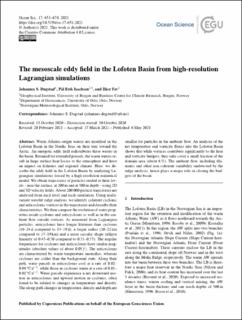| dc.contributor.author | Dugstad, Johannes Sandanger | |
| dc.contributor.author | Isachsen, Pål Erik | |
| dc.contributor.author | Fer, Ilker | |
| dc.date.accessioned | 2021-08-11T06:52:08Z | |
| dc.date.available | 2021-08-11T06:52:08Z | |
| dc.date.created | 2021-03-24T23:54:32Z | |
| dc.date.issued | 2021 | |
| dc.identifier.issn | 1812-0784 | |
| dc.identifier.uri | https://hdl.handle.net/11250/2767265 | |
| dc.description.abstract | Warm Atlantic-origin waters are modified in the Lofoten Basin in the Nordic Seas on their way toward the Arctic. An energetic eddy field redistributes these waters in the basin. Retained for extended periods, the warm waters result in large surface heat losses to the atmosphere and have an impact on fisheries and regional climate. Here, we describe the eddy field in the Lofoten Basin by analyzing Lagrangian simulations forced by a high-resolution numerical model. We obtain trajectories of particles seeded at three levels – near the surface, at 200 m and at 500 m depth – using 2D and 3D velocity fields. About 200 000 particle trajectories are analyzed from each level and each simulation. Using multivariate wavelet ridge analysis, we identify coherent cyclonic and anticyclonic vortices in the trajectories and describe their characteristics. We then compare the evolution of water properties inside cyclones and anticyclones as well as in the ambient flow outside vortices. As measured from Lagrangian particles, anticyclones have longer lifetimes than cyclones (16–24 d compared to 13–19 d), a larger radius (20–22 km compared to 17–19 km) and a more circular shape (ellipse linearity of 0.45–0.50 compared to 0.51–0.57). The angular frequencies for cyclones and anticyclones have similar magnitudes (absolute values of about 0.05f). The anticyclones are characterized by warm temperature anomalies, whereas cyclones are colder than the background state. Along their path, water parcels in anticyclones cool at a rate of 0.02–0.04 ∘Cd−1, while those in cyclones warm at a rate of 0.01–0.02 ∘Cd−1. Water parcels experience a net downward motion in anticyclones and upward motion in cyclones, often found to be related to changes in temperature and density. The along-path changes in temperature, density and depth are smaller for particles in the ambient flow. An analysis of the net temperature and vorticity fluxes into the Lofoten Basin shows that while vortices contribute significantly to the heat and vorticity budgets, they only cover a small fraction of the domain area (about 6 %). The ambient flow, including filaments and other non-coherent variability undetected by the ridge analysis, hence plays a major role in closing the budgets of the basin. | en_US |
| dc.language.iso | eng | en_US |
| dc.publisher | Copernicus Publications | en_US |
| dc.rights | Navngivelse 4.0 Internasjonal | * |
| dc.rights.uri | http://creativecommons.org/licenses/by/4.0/deed.no | * |
| dc.title | The mesoscale eddy field in the Lofoten Basin from high-resolution Lagrangian simulations | en_US |
| dc.type | Journal article | en_US |
| dc.type | Peer reviewed | en_US |
| dc.description.version | publishedVersion | en_US |
| dc.rights.holder | Copyright Author(s) 2021. | en_US |
| cristin.ispublished | true | |
| cristin.fulltext | original | |
| cristin.qualitycode | 1 | |
| dc.identifier.doi | 10.5194/os-17-651-2021 | |
| dc.identifier.cristin | 1900885 | |
| dc.source.journal | Ocean Science | en_US |
| dc.source.pagenumber | 651-674 | en_US |
| dc.relation.project | Notur/NorStore: NS9431K | en_US |
| dc.relation.project | Notur/NorStore: NN9431K | en_US |
| dc.relation.project | Norges forskningsråd: 250784 | en_US |
| dc.identifier.citation | Ocean Science. 2021, 17, 651-674. | en_US |
| dc.source.volume | 17 | en_US |

